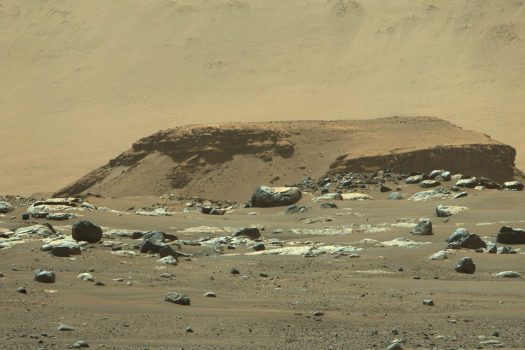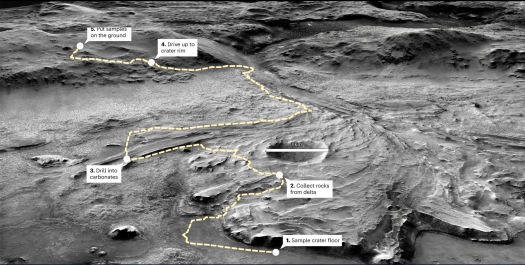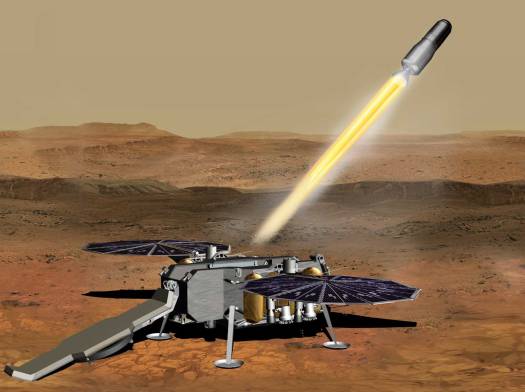
(NASA/JPL-Caltech/LANL/CNES/CNRS/ASU/MSSS)
One of the fondest dreams and top priorities of space science for years has been to bring a piece of Mars back to Earth to study in the kind of depth possible only in a cutting-edge laboratory.
While the instruments on Mars rovers can tell us a lot, returning a sample to study here on Earth is seen as the way to ultimately tease out the deepest secrets of the composition of Mars, its geological and geochemical history and possibly the presence of life, life fossils or of the precursor molecules of life.
But bringing such a sample to Earth is extraordinarily difficult. Unlike solar system bodies that have been sampled back on Earth — the moon, a comet and some asteroids — Mars has the remains of an atmosphere. That means any samples would have to lift off in a rocket brought to Mars and with some significant propulsive power, a task that so far has been a technical bridge too far.
That is changing now and the Mars Sample Return mission has begun. The landing of the Perseverance rover in Jezero Crater on Mars signaled that commencement and the rover will be used to identify, drill into and collect intriguing bits of Mars. This is a long-term project, with the best case scenario seeing those Mars samples arriving on Earth in a decade. So this entirely unprecedented, high-stakes campaign will be playing out for a long time.
“I think that Mars scientists would like to return as much sample as possible,” said Lindsay Hays, NASA Mars Sample Return deputy program scientist. “Being able to return samples that we collected with purpose is how we take the next step in our exploration of Mars.”
“And it seems that there are still so many unknowns, even in our solar system, even with the planets right next door, that every time we do something new, we answer a couple of questions that we hoped to and but also find a whole bunch of new things that we never expected.”
“I am so excited to see what comes of this adventure. And I think that is a feeling shared by Mars scientists and planetary scientists broadly.”

If all goes as planned, the Mars sample return campaign — which is a joint project of NASA, the European Space Agency (ESA) and the Canadian Space Agency — will unfold (and evolve) over the next decade.
The architecture of the mission involves two more launches from Earth to Mars, including the landing of the heaviest payload ever sent to Mars. Then comes an unprecedented robotic launch from Mars to an orbiting spaceship, which will be is tasked with returning the sample to Earth.
The first stage of the overall mission is the collecting of especially promising bits of Mars by the Perseverance rover, as we’ll discuss below. This process can go on for years, since the vehicle that will pick up the cached rocks won’t arrive until 2028.

That’s when a lander with a Mars ascent rocket (from NASA) and a robotic rover (from ESA) to fetch the cached samples will arrive, hopefully near where the Perseverance rover is now doing its work in Jezero Crater. The rover designed to pick up the canisters that will hold the cylinders of Martian samples will do its singular, though difficult, job and carry the canisters to the ascent rocket attached to the lander.
The canister will be loaded into the ascent rocket (robotically, of course) and this first ever lift-off on Mars is very tentatively scheduled for spring of 2029. The rocket will reach low Mars orbit and the canister will be ejected and will itself go into orbit.
Meanwhile, an ESA-built Earth return orbiter will have been launched and will be circling Mars, waiting for the canister to arrive. The container, the size of a soccer ball, itself does not possess any thrusters or a radio beacon. It is, however, white, which should make it easier to spot against the darkness of space.
When it does identify the canister the orbiter will be moved to its vicinity — said to be a pretty easy task — and as it approaches a hatch will open and the canister will be captured.
What would remain is the trip back to Earth and the descent of the Mars rocks in another specially designed vehicle.

The sample return process begins in earnest with the identification and collection, in a variety of ways, of particularly compelling specimen. This process will go on over the next few years as the Perseverance rover explores a large fossil delta in the Jezero Crater and then if the rover is healthy on to the plains of Nili Planum. Current plans are to deposit collections of samples in both areas.
Deltas are considered ideal locations for such sampling because rocks and soil from many settings around the crater will have been carried by water into the area, making one site in Jezero an aggregation of sites with very different geological and geochemical and geothermal pasts.

There will, of course, be no shortage of rocks and soil to choose from. But only about 40 samples of soil, pebbles and the drilled cores from rocks will be collected. Only about 30 of them are slated to be launched off Mars and transferred to Earth.
As currently planned, those samples won’t arrive on Earth until 2031. The samples won’t even be picked up until 2028. Nonetheless, the process of determining which kinds of samples to collect is under way, as is the planning for a biosafety level 4 facility — the highest level of biosafety precaution — that will house the Mars samples and where research will be done.
Elizabeth Hausrath, a geoscientist from the University of Nevada, Las Vegas is one of ten NASA “returned sample science participating scientists” chosen by NASA to help guide the sample selection and collection process. (ESA has some sample return participating scientists as well.) Hausrath has worked on rock-water interactions on previous Mars missions, and helped design the rock-collecting capabilities of Perseverance.
She said the goal of the scientists on the team are to “advance the interests of future scientists, to know what we want in these samples and what will be the most valuable for scientists in the long term.” On an operational level they will be on the constant lookout for specific rocks and settings that look promising — keeping a kind of extraterrestrial field book — and then they will be a voice (among others) for studying and perhaps collecting a particular sample.
Already, she said, the team is looking for and finding terrific potential samples to potentially bring home and it will be collecting samples “relatively soon.”


Igneous rocks, she said, are important to understand the evolution of Mars as a planet. Soil samples can give answers to question about the history of the Martian surface. And rocks containing carbon-based, organic compounds will be of special interest for their possibility of still encasing microfossils or types of biosignatures that tell of an ancient time when life was emerging or present on Mars.
This will be especially hard. Even on Earth, it was a formidable challenge to prove that microbial life existed billions of years ago—a discovery that occurred almost 100 years after Darwin predicted it. The trick was finding a material that could preserve cellular structures in which microfossils would be preserved — a scientific subdiscipline called taphonomy– and on Earth the first was silica.
Hausrath said that Jezero Crater has already been found to contain numerous kinds of elements and structures that can preserve materials of potential biological origins, including sedimentary layering of a fine-grained delta materials, amorphous silica, and carbonates.
To meet the challenge of detecting billions of years old microfossils or and biosignatures on Mars, the logic of tophonomy will clearly loom large.

Most of what will be placed into the collection cylinders will be cores produced by drilling into rocks and into the surface. Scientists will be looking for clues about the history, composition and habitability of Mars on an often molecular level, so don’t expect any dinosaur-like bones. Regolith will also be collected and some pebbles are expected to be part of those samples. Hausrath said these are called colloquially “jewelry boxes” because they will contain so many different and potentially valuable samples.
While the search for signs of ancient microfossils, for chemical biosignatures and for prebiotic molecules known to be part of the pathway to life on Earth grabs the most public attention, Lindsay Hays explains that is just part of the potential sample return treasure.

For instance, sample return will focus on gathering Mars rocks and soil with a wide range of ages. Currently the age of regions on Mars is estimated by the number of craters that can be counted — with more heavily cratered areas assessed as generally being older.
But the actual age of some features at Jezero can be determined by analyzing returned samples. For instance, some of the rock that makes up the crater floor appears to be consistent with a volcanic flow. If so, picking up a sample will likely be a high priority. When the sample is studied on Earth, researchers will be able precisely date when the volcanic eruption that created it took place. This information will then allow scientists to understand the timing of many geological events in and around Jezero.
Sample return will also have some very practical information that will aid the NASA humans-to-Mars program. Hays said that when Apollo astronauts landed on the moon, they were surprised by the sharpness and spikiness of the regolith — something which added to the difficulty of moving around. Mars sample return can help avoid that kind of problem.
And in more general ways, Hays wrote in an email, “there are two huge benefits that (sample return) has over any previous analyses of Mars samples.”
“Unlike in-situ measurements, for returned samples we can bring to bear any analytical technique or instrumentation present anywhere on the Earth (even things that have not yet been developed!) And we can do this in the naturally iterative process of science. When an answer leads to a new question we can follow that path and as well as save some sample for further analyses in the future as technology improves.
“On the other side of things, unlike the random ‘samples’ that have been delivered to the Earth from Mars as meteorites, we have the benefit of environmental context for samples collected with the Perseverance rover – we can take pictures and measurements of the parent rocks from which we collected the samples which will ultimately help in interpretation of what we find when we analyze these samples.”
Animation of drilling and caching by the Perseverance rover. (NASA)

While the time frame for bringing the precious samples to Earth is extended and perhaps frustrating as a result, the years are essential for developing some of the crucial technology. For instance, nothing like the Mars Ascent Vehicle has been built and tested and it requires significant time for development.
The same is true for the facility that will hopefully one day house the samples here on Earth. Unlike moon rocks which were sterilized before being studied, that process could destroy some of the signatures of ancient life in the Mars samples that scientists are looking for, and so some of these analyses must be done first in a secure facility. That means the issue of biohazards, while expected to be small, will nonetheless be of primary importance.
Because of these issues and more, a NASA independent review board concluded earlier this year that while the sample return program was sound and should go forward, they recommended that the proposed timeframe for the next launches be changed. Based on the NASA track record for preparing and launching missions, they said the missions to retrieve the samples were unlikely to be ready for their proposed launch dates in 2026 and 2028.
Hays said that current plans, however, are to maintain their current schedule. One reason has to do with what surface landing conditions would be like based on the cycles of Mars positioning and climate.
“We are well aware the timeline is fairly ambitious but we want to continue pushing,” she said. “We think we have the time needed for the innovations required. So, like any trip, it makes sense to aim for when Mars would have the best conditions for our adventure.”
There is much more to be said about the sample return effort, which is crucial to the advancement of astrobiology, planetary science and so much more. And so future columns will be written for sure.

2 Replies to “The Hows and Whys of Mars Sample Return”
Comments are closed.